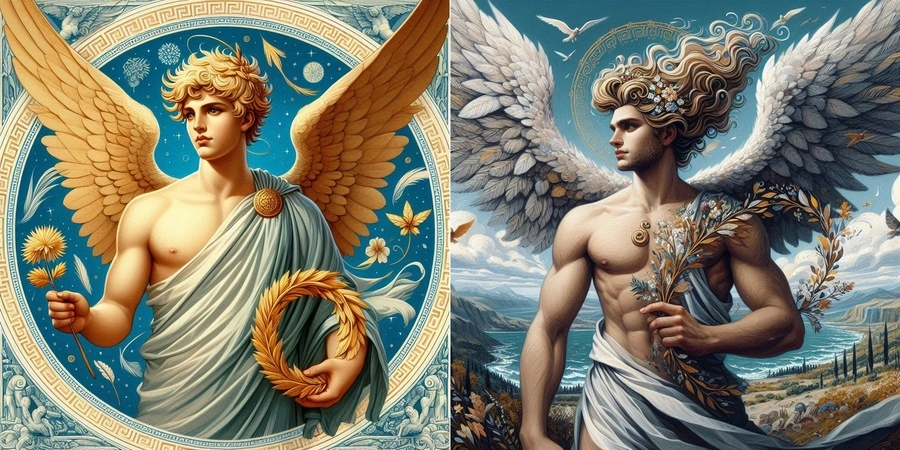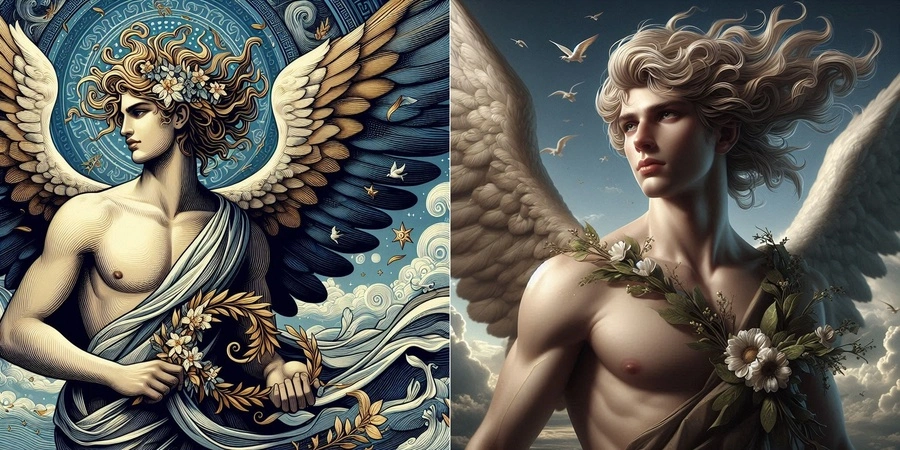
In Greek mythology, Zephyrus was the god of the west wind, one of the four winds and the son of Astraeus, the Titan of dusk and the starry sky, and Eos, the rosy-fingered goddess of dawn. He was often depicted as a handsome young man with wings, carrying a wreath or flowers in his hand.
Zephyrus, also spelled as Zephyros or Zephyr, is one of the four Anemoi, the wind gods who each ruled a cardinal direction. His siblings include Boreas, the god of the north wind; Notus, the god of the south wind; and Eurus, the god of the east wind.
He was also believed to have several children, including two winged horses named Balius and Xanthus, who were given as a gift to the Greek hero Achilles.
The Story of Zephyrus
One of the most famous myths involving Zephyrus is the tale of Chloris, the goddess of flowers, who later became known as Flora in Roman mythology. According to the legend, Zephyrus fell in love with Chloris and abducted her. Despite the unconventional beginning, their union was harmonious and fruitful.
As a gesture of love, Zephyrus transformed Chloris into the goddess of flowers, allowing her to preside over spring and blossom the earth with vibrant life. Their relationship symbolizes the intimate bond between the wind and the flora it helps nurture.
Zephyrus also plays a pivotal role in the myth of Psyche and Eros. When Psyche is abandoned on a mountaintop to meet her mysterious husband, it is Zephyrus who gently carries her to Eros’s palace, a testament to his role as a bringer of gentle change and transportation.
Another notable myth is his rivalry with his brother Boreas over the love of the harpy Podarge. This story highlights the contrasting nature of the winds they personify: Zephyrus’s soft, warm breezes against Boreas’s cold, forceful gales. Their competition also underscores the dynamic interplay of different natural forces within Greek mythology.

Zephyrus was also associated with the season of spring and the rebirth of nature after the long winter. It was believed that he was responsible for bringing warm, gentle breezes that would encourage the growth of new plants and flowers. He was often depicted as a playful, mischievous god who delighted in causing mischief and stirring up trouble.
In addition to his romantic pursuits, Zephyrus was also responsible for carrying the goddess of love, Aphrodite, across the sea to her lover, Adonis. He was said to have helped Aphrodite in her quest to win the heart of the mortal Adonis, and his gentle breezes were said to have helped the flowers and plants of the earth bloom with renewed vigor.
10 Myths and Facts About Zephyrus
- Zephyrus and Hyacinth: One lesser-known myth involves Zephyrus and Hyacinth, a beautiful Spartan prince loved by both Zephyrus and Apollo, the sun god. According to the myth, Zephyrus, overcome with jealousy over Hyacinth’s preference for Apollo, blew a discus thrown by Apollo off course, striking and killing Hyacinth. In his grief, Apollo transformed Hyacinth’s spilled blood into the flower that bears his name.
- The Name Zephyrus: The name Zephyrus comes from the Greek word “zéphuros,” which means “the west wind.” This etymology underscores his direct association with the wind that blows from the west, symbolizing the transition from winter to spring and bringing the warmer weather that nurtures growth and renewal.
- The Rescue of Pandora’s Jar: In another myth, when Pandora opened her jar and released all the evils into the world, Zephyrus played a crucial role in mitigating the disaster. It is said that he carried away Hope, the last thing left in the jar, and spread it across the world with his gentle winds.
- Zephyrus and Iris: Zephyrus was said to be the consort of Iris, the goddess of the rainbow and messenger of the gods. Their union symbolizes the connection between the wind and the rainbow, phenomena that often appear together in the natural world. This relationship also underscores the idea of Zephyrus as a bridge between different elements of nature, harmonizing the skies with his gentle breezes.
- A Controversial Role in Abduction: The myth of Persephone’s abduction by Hades is well-known. However, some versions hint at Zephyrus’ involvement. In these tales, Zephyrus, either on his own or at Hades’ behest, aids in luring Persephone away from the meadow, allowing Hades to snatch her and take her to the underworld.
- Not Just a Gentle Breeze: While often depicted as gentle, Zephyrus wasn’t above destructive outbursts. One myth tells of his rage upon learning of Hyacinthus’ death. In a jealous fury, he unleashed a violent storm, devastating the land in a display of his untamed power.
- A Herald for More Than Spring: While spring was his primary domain, Zephyrus also served as a messenger for other deities. In some myths, he acts as a herald for Hera, the queen of Olympus, carrying her messages across the vast expanse of the sky.
- The Creation of the Etesian Winds: According to another myth, Zephyrus was responsible for creating the Etesian winds, annual summer winds that blow across the Aegean Sea. These winds were seen as a gift from Zephyrus to the people, providing relief from the summer heat and aiding sailors in their journeys. This myth emphasizes Zephyrus’s role in moderating the climate and supporting human activities.
- Beyond Greece: The concept of a benevolent west wind god wasn’t exclusive to Greece. The Egyptians worshipped Zephyr, a deity with similar characteristics, highlighting the cross-cultural influence of wind deities.
- Symbol of Change: Zephyrus is often considered a symbol of change and transformation. His west wind marks the transition from one season to another, signifying new beginnings and the cyclical nature of life. In this way, Zephyrus represents the ever-changing yet constant rhythms of the natural world, a force that is both predictable and full of surprises.

The Symbols of Zephyrus
The West Wind
The most direct and primary symbol of Zephyrus is the west wind itself. This wind, known for its mildness, heralds the arrival of spring, bringing warmth and nurturing the earth after the harshness of winter. It is a wind that encourages the blossoming of flowers and the growth of crops, symbolizing renewal, fertility, and the gentle force of nature. The west wind’s temperate and refreshing qualities are core attributes of Zephyrus, reflecting his benevolent influence on the natural world.
Flowers and Blossoms
Flowers, particularly those that bloom in spring, are potent symbols associated with Zephyrus. In mythological tales, Zephyrus is often depicted with flowers, highlighting his connection to growth and rejuvenation. For example, in the myth involving Zephyrus and Chloris (who later becomes Flora, the goddess of flowers), his breath brings forth blooming flowers, symbolizing the transition from winter to spring. This connection underscores Zephyrus’s role in fostering life and beauty in nature.
The Gentle Breeze
The gentle breeze is another significant symbol of Zephyrus. Unlike the fierce winds of his brother Boreas, the north wind, Zephyrus’s breezes are soft and calming. This gentle nature represents subtlety, tranquility, and the quiet power of positive change. In various myths and artistic representations, Zephyrus is shown as a bringer of calm, peaceful weather, embodying the soothing aspect of nature’s rhythms.
Wings
Zephyrus is often depicted with wings, symbolizing his swiftness and his role as a wind deity. The wings signify freedom, movement, and the ability to traverse great distances. In artistic representations, these wings often appear delicate and light, mirroring the gentle nature of the west wind. The imagery of wings also connects Zephyrus to the broader Greek mythology theme of divine messengers and beings who bridge the gap between the heavens and the earth.
The Harp
In some artistic and literary traditions, Zephyrus is associated with the harp, an instrument that produces melodious and soothing sounds. This symbol highlights the harmonious nature of Zephyrus’s winds, which, like the music of a harp, bring comfort and joy. The association with the harp emphasizes the idea of Zephyrus as a gentle force that brings balance and harmony to the natural world.
Rainbows
Zephyrus is sometimes linked to rainbows, which often appear after rain when the sky clears, and the west wind blows. The rainbow, a beautiful and transient phenomenon, symbolizes hope, promise, and the bridging of different elements. This connection to rainbows underscores Zephyrus’s role in bringing change and renewal, serving as a reminder of the natural beauty that follows life’s storms.
Transformation and Change
Transformation is a key symbolic theme associated with Zephyrus. His winds mark the changing of seasons, the renewal of life, and the end of dormancy. This transformative power is evident in myths where Zephyrus’s breath revives the earth and brings about new growth. The concept of transformation aligns Zephyrus with broader themes of life, death, and rebirth, reflecting the cyclical nature of the natural world.
The Zephyr
The term “zephyr” itself has come to symbolize a light, gentle breeze, often one that carries a sense of mildness and pleasantness. This modern usage retains the essence of Zephyrus’s characteristics and keeps his mythological influence alive in contemporary language. The zephyr as a symbol represents not just a physical breeze but also the idea of delicate and positive change, aligning with Zephyrus’s gentle and nurturing nature.
Nature and the Elements
Zephyrus’s connection to nature and the elements is a pervasive symbol in Greek mythology. His influence on weather patterns, plant growth, and seasonal cycles positions him as a crucial force in the natural order. This deep association with nature symbolizes the interconnectedness of all living things and the harmonious balance that the gods maintain within the world.